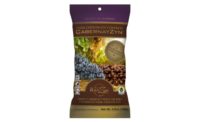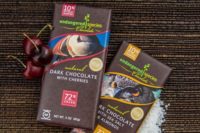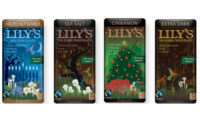
Dark Chocolate
|
Estimated U.S. Retail Market Size
$600 million
Source: The Nielsen Company/Nielsen Scantrack |
Category Climate
Sure, the flavor is bittersweet, but sales certainly
are not. Dark chocolate has taken the country—and
confectionery—by storm. The National Confectioners Association (NCA)
has just released its 2007 calculations showing dark chocolate sales
excelled by 50 percent over 2006. Also consider these facts and figures
from a recent report on the segment from The Nielsen Company:
The dark chocolate category is worth approximately $600 million in
sales and has grown by more than 122 percent in the past five years; this
translates to a compounded annual growth rate of 17 percent.
Dark chocolate’s share of the total chocolate category has
doubled in five years to 10 percent.
Dark chocolate is growing at eight times the rate of the entire
chocolate candy category.
Across the Food/Drug/Mass channels (excluding Wal-Mart) the
average number of dark chocolate SKUs carried is fast approaching 50; this
number five years ago was 17.
Other industry research reveals that while there is
growth in both non-premium and premium dark chocolate, the latter segment
demonstrates the strongest sales and share increases. Apparently, consumers
are quickly recognizing the quality difference among dark chocolate
offerings, while more mass-market retailers are enabling them to trade up
to higher-quality dark-chocolate brands and price points.
Target Audience/Pricing
Career women, baby boomers, coffee drinkers, wine
lovers, Hispanics, seniors and even “men in trees” ... the
beauty of the dark chocolate surge from a marketing perspective is that it
has allured adult consumers from all walks over to its “dark
side.”
That said, there is a growing appreciation and
sophistication among dark-chocolate consumers; many are becoming more
discerning in their search for higher-quality dark chocolate. Thus, there
are some sub-segment customer highlights to be noted, and they come from
the premium chocolate category, one found to greatly overlap that of dark
chocolate. Research has revealed that while premium chocolate is growing
wildly in sales and share, and dark chocolate is growing concurrently,
premium dark chocolate is growing (and overlapping) at the wildest growth
points of all.
The multitude of marketers who are looking to enhance
their premium dark chocolate lines should understand that between men and
women, it is the women who are more likely to put their money where their
better, darker chocolate is. In a special premium chocolate market report
released last year, Mintel revealed that overall women respondents were
willing to pay more than $1.25 per pound more (on average, $7.79 per pound)
for “very high quality” chocolate vs. overall men respondents
(who were willing to spend, on average, $6.52 per pound).
Of the age segments, men and women ages 18-34 were
willing to spend the most on premium/dark chocolate, according to Mintel.
Not surprisingly, income levels have a lot to do with
the price spent on good, dark chocolate, too. Mintel revealed that
households earning $100K a year or more were willing to spend the most of
any segment on premium/dark chocolate—on average, $8.76 per pound.
Interestingly though, those households earning less than $25K a year were
still willing to spend $6.47 per pound (the average across all incomes was
$7.21).
Various regions of the country also produced
differences in consumer willingness to spend more for better-quality dark
chocolate. Those in the Northeast and West scored higher price-wise than
the South and Midwest.
While the benchmark for premium chocolate has
historically started at $8 per pound—that, like much of the dark
chocolate, is being traded up. “Super premium” dark chocolate
has now gained traction, commanding price points of $16 per pound and
higher.
Packaging
The finest dark chocolate has typically been offered
up as bars, inner-wrapped in silver or gold foil, but the popularity of the
category has expanded that to include more packaging that fits the
lifestyles of today’s consumers. This includes mini “pop”
tins for purses and pockets of people-on-the-go, as well as weatherproofed,
hand-dipped wax casings for backpackers and hikers.
The prevalence of more young-adult and female
dark-chocolate connoisseurs has also led the industry to reconfigure its
traditional and non-traditional packaging to be more colorful,
“hip” and descriptive in flavors and undertones.
Numbers are almost a dark chocolate package necessity
now—meaning, of course, the numbers that reveal the cacao (often
termed cocoa) content. The minimum requirement of dark chocolate is 43
percent, according to European standards, but American consumers are
generally seeking out cacao content much higher than that—56, 60, 70,
85, even 99 percent for the “diehard darkies.”
More consumers understand today that the percentage
number on a bar’s wrapper represents the bar’s weight that
actually comes from the cacao bean. The rest of a chocolate bar is almost
entirely sugar, so a “70 percent” chocolate bar will contain
about 30 percent sugar.
Retailing/Merchandising
A dedicated dark chocolate section is becoming the
industry standard, even in supermarkets. With the continual SKU
proliferation, it’s the only way to keep the category organized and
moving. Retailers typically plan-o-gram by brand or cacao content, and by
flagging “new” items.
Retailers are recognizing the analogy/pairing of dark
chocolate and wine, and some are starting to play that up in-store by
merchandising wine and good-quality chocolate side by side, on a shelf, in
a basket, at an endcap, and coupling that with signage explaining which
wines go with which chocolate. Retailers are also sampling wine and
chocolate together at in-store tastings and events, much to the delight of
adult shoppers, who are quickly catching on to the increasingly more
mainstream taste trend. Strong coffees, teas and even some carbonated
beverages are gaining momentum in the coupling at retail, too.
Outlook
The growing appreciation and sophistication of
dark-chocolate consumers will continue to fuel the category with
unprecedented growth. This includes “fusion,” which includes
the combination of dark chocolate with more spices, hot peppers, fruits,
citrus rinds, and sea salt. More sophisticated/contemporary palates will
also give way to the increased popularity of single-origin chocolates and
upscale chocolates with more “urban-sounding” names.
Additionally, strong consumer interest in the reported
health benefits of dark chocolate is predicted to increase.
Quick Bites
Dark chocolate is
the fastest-growing candy segment.
Women and young
adults will spend more for premium/dark.
The days of wine
and dark chocolate are here.
There is the
promise of more fusion in the future.



